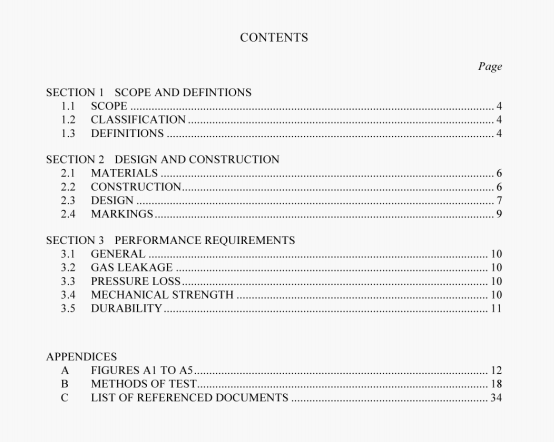AS 4627:2005 pdf – Quick-connect devices for gas.
This test applies to all quick-connect devices.
B7.2 METHOD
The quick-connect device is tested for leakage to atmosphere, with the valve both open and closed, by means of a leak detector and air at the specited pressure.
rhere the rated working pressure of the device under test exceeds 1050 kPa a hydrostatic safety check is carried out in accordance itli M.O.T. 3.2.1(B) prior to completion of the leakage test described below.
B7.3 APPARATUS
The following apparatus, as depicted in Figure A3:
I Air inlet valve.
2 Adjustable pressure regulator.
3 Air bypass valve.
4 Leak detector suitable for maximum test pressure and capable of measuring I mlimin with an accuracy of ±0.3 mL/min e.g. bubble leak detector (see Figure A2). electronic leak detector.
5 Leak detector inlet, outlet and bypass valves.
6 Pressure gauge to indicate up to at least 1.5 times the rated working pressure or 14.0 kPa. whichever is the greater, with an accuracy of ±2% FSD.
7 Mating plug (which may be part of a hose) for quick-connect device socket.
B7.4 MATERIALS
1 Air supply at 1.5 times the rated working pressure or 14.0 kPa. whichever is the greater.
2 Soap and water solution.
B7.5 PREPARATION OF APPARATUS
1 Assemble apparatus (see Figure A3) and check for gas tightness up to inlet of quick- connect device with leak detector.
2 Seal device outlet, open manual valve or remove plug and check outlet connection for leaks with soap solution.
3 Close manual valve or replace plug.
B7.6 PROCEDURE
1 Open air bypass valve ABV and leak detector bypass valve LDB.
2 Close leak detector inlet and outlet valves LDI and LDO.
3 Open air inlet valve IV.
4 Adjust regulator AR and air bypass valve ABV to give pressure gauge reading of
1.5 times the rated working pressure or 14.0 kPa. whichever is the greater.
5 Open leak detector valves LDI and LDO. close LDH.
6 Readjust pressure as in Step 4 above, if necessary, and allow 1 mm to s(abili,e.
7 Observe leak detector.
8 Open manual valve or remove plug.
9 Observe leak detector.
H8.3 APPARATUS
1 Test rig capable of sustaining a hydrostatic test pressure of at least 1.5 times the maximum operating pressure of the device.
2 Suitable pressure gauge(s) to indicate at least the pressure in I (as above) %%ith an accuracy of ±1% FSD.
3 Hydraulic supply system capable of producing at least the test pressure in I (above).
B8.4 PREPARATION OF APPARATUS
1Install quick-connect device into the test rig as in Figure A4.
2 Open device and hold in open position.
3 Fill quick-connect device with water, completely expelling the air.
NOTE: It is essential to expel all air to reduce the potential damage caused by any sudden release of
compressed air.
4 Seal outlet of quick-connect device on test.
B8.5 PROCEI)URE
1 Close control valve CV1 and bleed valve 1W. Open all other control valves.
2 Increase the pressure slowly and steadily to 1.5 times the manufacturer’s working pressure.
3 Hold this pressure for 1 mm.
4 Observe any fracture or deformation.
AS 4627:2005 pdf – Quick-connect devices for gas
